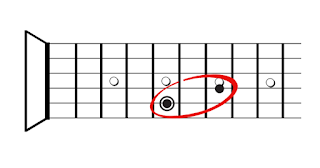3 Simple Shapes for Beautiful Chords (ANYONE CAN PLAY!)
In this video, I’m going to show you the three best intervals for building up your riffs so that the riffs are more melodic without necessarily having to focus all of your time training on learning every note name, or a lot of music theory.
This lesson focuses on 3 shapes that are not only easy to play but when they’re combined with a few open strings you’ll achieve a beautiful sound that strongly connects all of these shapes together.
Typically, we refer to these shapes as intervals, because they only have two notes.
One of these shapes will quite likely be VERY familiar to you, (and depending upon what you’ve studied in the past, it’s quite likely that the other two shapes may also be somewhat familiar as well).
Let’s get things started by running through each of the three shapes. Then we’ll get into a number of different playing options that you can use with them to start making some music.
Example 1): The Minor Third
In this first shape we have a pattern that stretches across a whole step between two strings. The interval is referred to as a “Minor 3rd.”
Example 2): The Major Third
Our second shape is a smaller pattern that applies a half step between two strings. The interval is referred to as a “Major 3rd.”
Example 2): The Perfect 5th
Our last shape is another pattern a whole step apart between two strings. The interval is referred to as a “Perfect 5th,” however, more commonly it will be referred to as a “Power Chord.”
I wanted to take a minute to let you know, that if you want to learn even more about scales and theory I have a great offer for you.
With any donation over $5, or any merchandise purchase from my Tee-Spring store, I’ll send you free copies of THREE of my most popular digital handouts.
One is called, “Harmonized Arpeggio Drills” (it’ll train you on developing your diatonic arpeggios).
Another one is my “Barre Chord” Handout which includes a page showing all the key signatures along with a chord progression that applies barre chords.
Plus, you’ll get my Notation Pack! It has 8 pages of important guitar worksheets for notating anything related to; music charts, guitar chord diagrams, and TAB.
As a BONUS, (from my "Over 40 and Still Can't Play a Scale" video), I'll also throw in a breakdown of all of the chords that are diatonic to the "F Major" scale.
As an EXTRA BONUS for my Phrygian Dominant video, I'll also throw in a breakdown featuring all of the chords that are diatonic to the Phrygian Dominant scale.
Just send me an email off of the contact page of CreativeGuitarStudio.com to let me know about either your donation or your Merchandise purchase and I’ll email you those digital handouts within 24 hrs.
____________________________________________________
CONCLUSION:
Once you become familiar with these three shapes the fun can really start for you. And, as you’re about to see and hear, it is very easy to apply these shapes (and use them to develop really beautiful sounding music).
But, the best part is that you won’t need to know any note names on the neck, and you don’t need to understand anything about music theory.
The shapes can be moved anywhere along the neck and you can even combine them in all sorts of random ways against open strings for some very cool sounding layered effects.
So, when you understand the fact that these shapes are super easy to play and how these shapes can be applied in any way that you’d like on the neck, you wind up with tons of options for their application in music.
Let’s wrap up by exploring those options with a melodic example…
Example 4): Melodic example DEMO (Key of “E Minor”)










